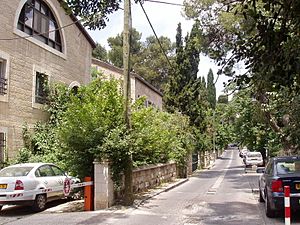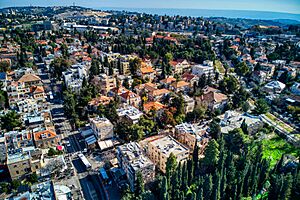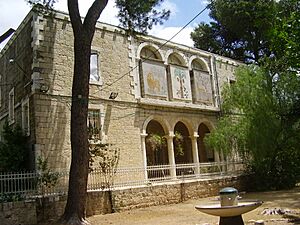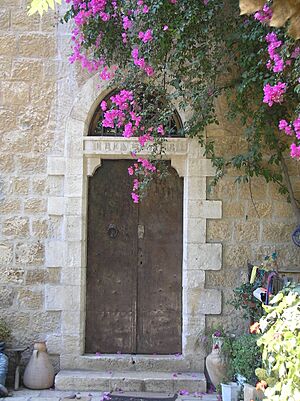German Colony, Jerusalem facts for kids
Quick facts for kids
German Colony
|
|
|---|---|
|
Neighborhood of Jerusalem
|
|

Cremieux Street
|
|
| Country | |
| District | Jerusalem District |
| City | Jerusalem |
| Foundation | 1873 |
| Founded by | German Templer Society |
| Population
(2017)
|
|
| • Total | 1,930 |
The German Colony (Hebrew: המושבה הגרמנית, HaMoshava HaGermanit) is a cool neighborhood in Jerusalem. It was started in the late 1800s by a group called the German Templers. Today, this area, often called the Moshava, is a fancy place. It has a main street called Emek Refaim Street, which is full of trendy shops, restaurants, and cafes.
Contents
History of the German Colony
Ancient Times
The area where the German Colony now stands was once known as the Valley of Rephaim. This valley is even mentioned in ancient books like the Book of Joshua and the Second Book of Samuel. Its name comes from old stories about a legendary race of giants who were said to live here long, long ago.
The Templers Arrive
In 1873, a group called the Templers moved to Jerusalem. They were Christians from Germany who wanted to live in the Holy Land. They had already started colonies in other cities like Haifa and Jaffa.
They bought a large piece of land in the Refaim Valley, southwest of Jerusalem's Old City. The Templers built their homes just like they did in Germany. These were one or two-story farmhouses with slanting tiled roofs and windows with shutters. But instead of wood and bricks, they used local materials like Jerusalem stone.
The Templers were farmers and also worked in traditional jobs like carpentry and blacksmithing. Their homes were built along two main streets, which are now Emek Refaim and Bethlehem Road. One famous resident was Friedrich (Fritz) Kübler, a butcher. He raised animals and had a slaughterhouse. His son later became one of the biggest meat suppliers in Jerusalem.
During World War II, the British government, which ruled the area then, sent the German Templers away. This was because some of them supported Germany during the war. Many of them later moved to Australia.
Christian Arab Families Move In
As the German Colony grew, many wealthy Christian Arab families bought land there. They liked the location because it was between the road to Bethlehem and other growing neighborhoods. These areas included Katamon, Talbiya, and Baka, where some of Jerusalem's richest Arab families lived.
The State of Israel is Formed
In 1948, during a war, many Arab residents left their homes in Katamon and the German Colony. These empty houses were then used to house new immigrants coming to Israel.
Since the late 1900s, the neighborhood has become more modern and popular. People have worked to fix up old buildings, keeping their unique features like arched windows and tiled roofs. Many new cafes, bars, restaurants, and shops have opened. This has made the area very popular, and many well-off families have moved in, which has made house prices go up. The German Colony is also home to many people who speak English, including families and young adults.
Buildings and Street Names

The German Colony has a cool mix of building styles. You can see German-style homes, old Ottoman buildings, and British Art Deco designs from when the British ruled. For example, the Scottish Hospice and St Andrew's Church, built in 1927, have beautiful local Armenian tiles. Some Templer homes even have Bible verses written in German above their doorways.
The smaller streets in the German Colony are named after people who supported the idea of a Jewish homeland. These include the French writer Émile Zola, Czech president Tomas Masaryk, Adolphe Crémieux, and South African prime minister Jan Smuts. Many streets are also named after British people, like Prime Minister David Lloyd George, MP Josiah Wedgwood, Colonel John Henry Patterson, and General Wyndham Deedes.
Parks and Fun Activities
The Park HaMesila, also known as the Train Track Park, runs along the southern edge of the German Colony. This used to be a train track but was turned into a park about 7 kilometers long. The part next to the German Colony has been beautifully designed with plants and paths. There's even a 'Bus Stop Library' where you can donate books or find something new to read!
Important Landmarks
- Gemeindehaus, communal hall – 1 Emek Refaim Street
- Friedrich Aberle House – 10 Emek Refaim Street
- Matthäus Frank House – 6 Emek Refaim Street
- Pension Schmidt
- Lev Smadar Theater – formerly Orient Cinema, Lloyd George Street
- Convent of Borromean Sisters – 12 Lloyd George Street
- Templer Cemetery – 39 Emek Refaim Street
- Imberger House
- Shalom Hartman Institute – 11 Gedalyahu Alon Street
- Kivunim Gap Year Headquarters, Yemin Moshe Street
Future Plans
For many years, people have wanted to build more in the northern part of the neighborhood, near Liberty Bell Park. In the 1970s, there were big protests against building a tall apartment building called the Omariya compound. Because of protests from people who care about the environment and the neighborhood, plans for a new hotel were changed. It was originally going to be 14 stories tall, but now it will only be seven stories.
Famous People Who Lived Here
- Batya Gur, an Israeli writer
- Charles Winters, an American businessman
See also
 In Spanish: Colonia Alemana (Jerusalén) para niños
In Spanish: Colonia Alemana (Jerusalén) para niños





